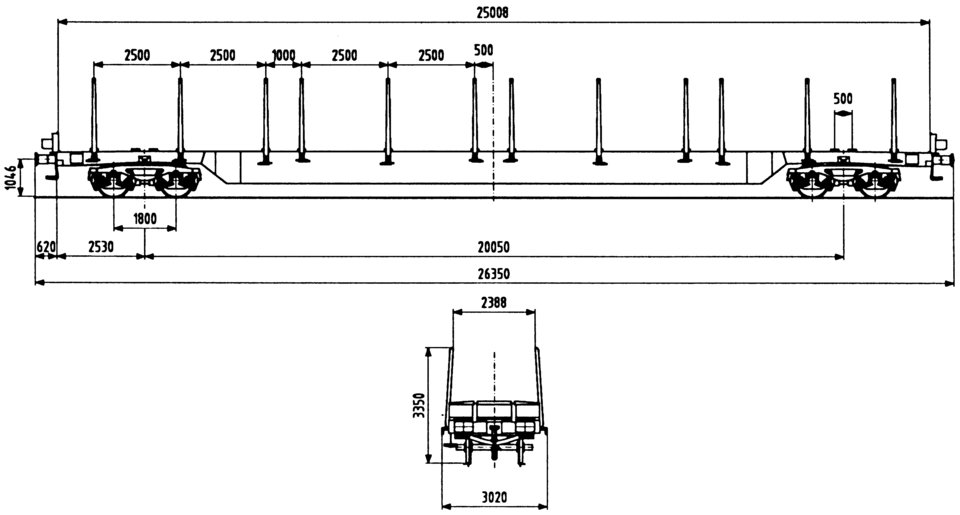Article: Rbns 641
Bogie flat wagon with four wheelsets, with stanchions and drop ends, but without drop sides. The wagon is used for transporting very long mining products and long square-sawn timber.
Technical details
Loading length (mm) | 25,008 |
Loading width (mm) | 2,590 |
Loading area (m2) | 65.0 |
Average tare weight (kg) | 27,000 |
Maximum speed (km/h) | 120 |
International usability | Derogation plate with railway/country code: PKP/51, MAV/55, ÖBB/81, CFL/82, FS/83, NS/84, SBB/85, SNCF/87, SNCB/88. Wagon No. 81 80 3507 000-7 to 151-8. |
Smallest radius of curvature (m) | 75 |
First year of delivery or year of construction of the oldest wagons at this time | 1997 |
Parking brake | Without parking brake |
Brake type | KE-GP-A |
Number of brake cylinders (pcs.) | 1 |
Brake cylinder diameter (mm) | 406 |
Type of load-proportional braking | Automatic |
Buffer type | Category C (ETH) |
Buffer head dimensions (mm) | 550 x 340 |
Automatic coupler | Prepared |
Distributor valve type | KE 2dSL-ALB/d8 |
Individual data
Height of drop end above top edge of bolster (mm) | 454 |
Height of stanchions above top edge of bolster (mm) | 2,000 |
Height of bolster above top of floor (mm) | 100 |
Height of bolster above top of rail (mm) | 1,350 |
Load limits
Tare weight > 26.5 t ≤ 27.0 t
The wagons of this type can have different load limits and concentrated loads due to having different tare weights.
A | B | C | D | ||
|---|---|---|---|---|---|
S | 37.0 t | 45.0 t | 55.0 t | 63.0 t | |
120 |
DB | CM | PKP | C |
|---|---|---|---|
100 | 57.0 t | 100 | 52.5 t |
Concentrated loads
m | Spread over the support length | On two baseplates | |
|---|---|---|---|
a-a | 6 | 28.3 | 34.7 |
b-b | 11 | 44.0 | 55.0 |
c-c | 13 | 47.0 | 59.0 |
d-d | 18 | 56.0 | 60.0 |
e-e | 20 | 61.2 | 63.0 |
f-f | 23 | 63.0 | 31.0 |
Additional information:
The welded underframe, which is made of S355J2G3 grade steel, is pre-bent by 30 mm in the middle of the wagon when empty and sags by 25 mm when loaded.The wagon floor between the bolsters is made of 3 mm thick checker plate, which can be walked on, but which must not be loaded with cargo or vehicles. Only the bolsters (16 pieces, 200 mm wide, 100 mm high), which can be nailed in the middle and are made of a hardwood-softwood combination, absorb all the vertical forces of the loads.
For transport requirements in which the straightness of the mining products must be ensured after transport too, shippers may place up to three auxiliary bolsters between the fixed bolsters. The auxiliary bolsters must not be used for concentrated loads, must be supported on the top chords of the solebars, must not put any load on the wagon floor plate and must be secured against lateral slipping by using binding wire through the bores in the top chord.
The heavy-duty swivel stanchions (12 pairs) are made of special steels and tilt approximately 125 mm inwards when unloaded. Any permanent deformation of the swivel stanchions caused by improper loading and unloading can only be rectified by replacing the stanchions. The drop ends serve to secure the load when in a vertical position and must not be driven over in a horizontal position. The wagon can run with the drop ends folded down and the end stanchions lowered (track curves ≥ 150 m radius).There are ten indirect fastening devices on the wagon (tensioning winches with strap, 40 kN nominal breaking force) and lashing rings for securing or covering the load. The lashing rings on the solebars can be loaded with 60 kN and those on the drop ends with 40 kN.
For tensioning the straps, an operating lever for the winch is located in the middle of the solebar (operating side).
All data provided without any guarantee of correctness or completeness.
